Istanbul is famous not only for its historical and cultural richness but also for its amazing islands. The islands of Istanbul offer the beauty of the Marmara Sea and are the perfect escape destination for those looking to get away from the hustle and bustle of the city. Here is detailed information about each island of Istanbul.
Büyükada
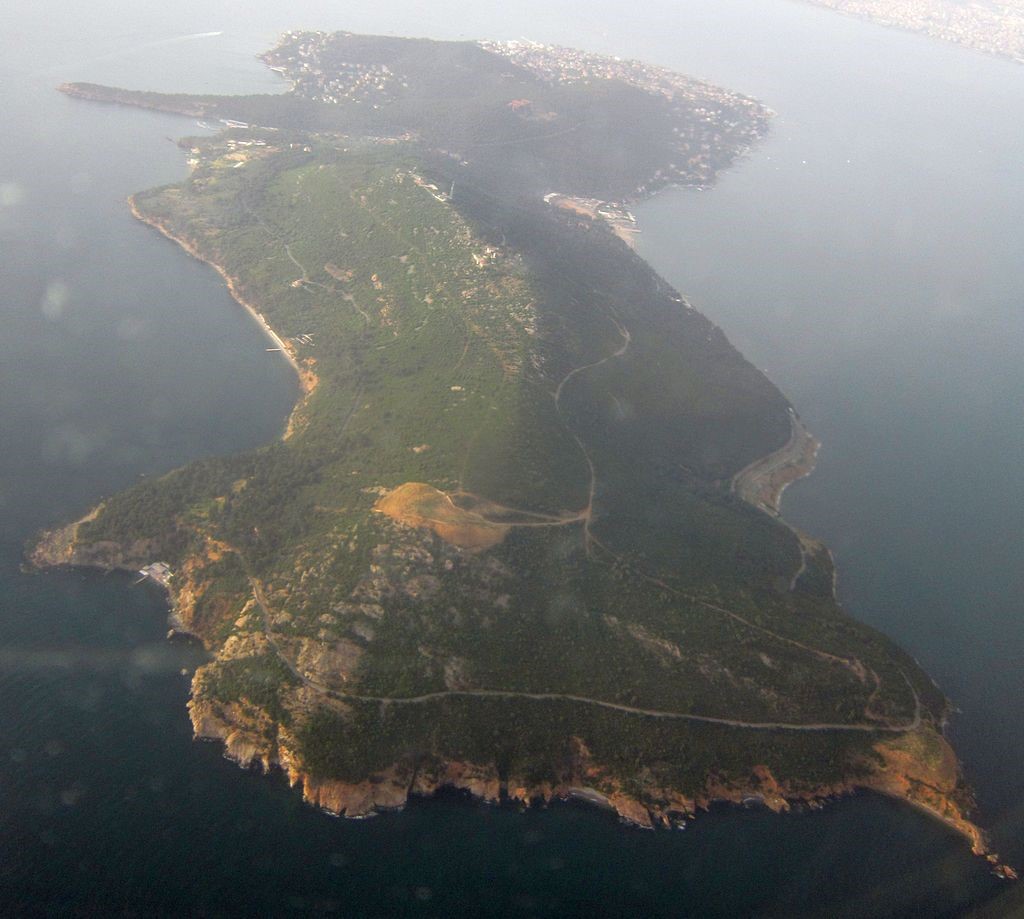
Büyükada is the largest and most popular island of Istanbul. The island, which attracts a large number of visitors during the summer months, is famous for its wide beaches, historic mansions and lush forests. One of the most important symbols of the island is the Hagia Yorgi Church and Monastery, built in the 6th century. Visitors can visit this historical building by hiking or cycling from the center of the island to the top of the hill.
Etymology
Büyükada was recorded under the name of Kızılada in Evliya Çelebi’s Seyahatnâme (travelogue), which dates to the mid-17th century. The island is mentioned under the name Pityoússa/Pityoúdes in Hesyxios of Alexandria’s (ἩσύχιοςὁἈλεξανδρεύς) Leksikon dated 540. In the 9th century, in Theophanes’ Chronicles (Chronikon), it was recorded under the name Prinkipos.
History
AtatürkEffigy and Turkish flags in the square of Büyükada
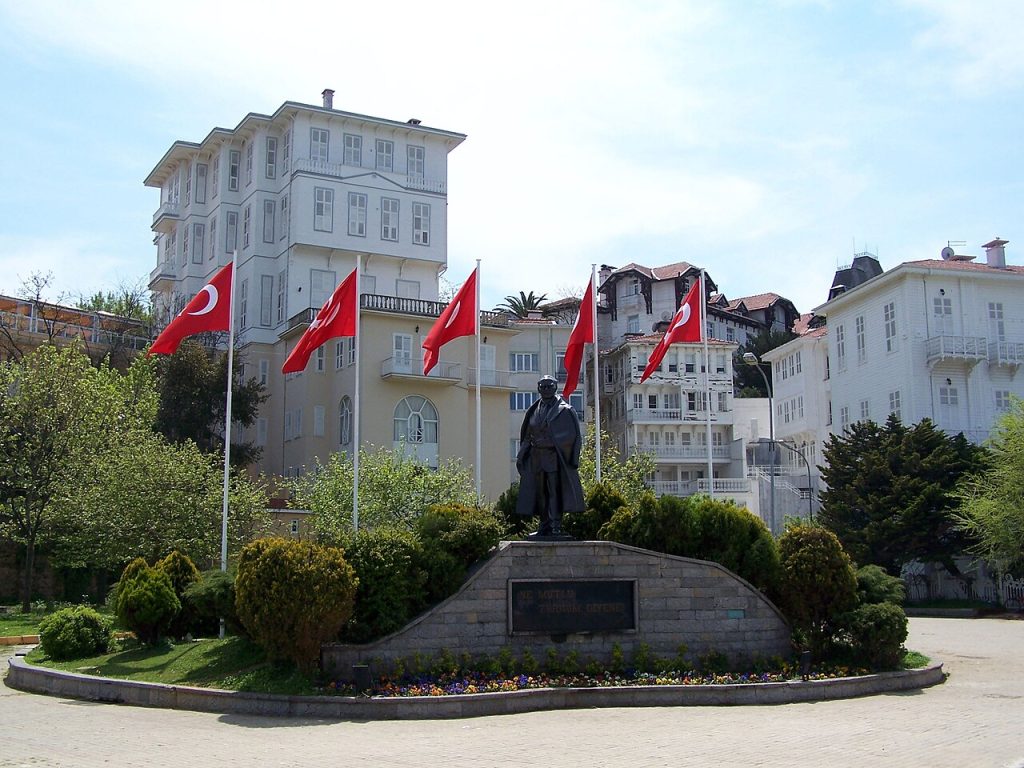
Found in 1930 near the Greek Orthodox cemetery in Karacabey, the Büyükada Treasure, which contains gold coins belonging to Philip II, the king of Macedonia, father of Alexander the Great, is the oldest finding related to the history of the island. The treasure, consisting of 207 gold coins, is now in Istanbul Archaeology Museum. Like the other Princes’ Islands, Büyükada was also used as a place of exile during the Byzantine period. The islands were conquered by Fatih Sultan Mehmet one month before the Conquest of Istanbul.
Having lost its Greek population after World War I and the Republic, Büyükada’s dynamism was largely lost until the 1930s. However, towards the 1940s, it regained its status as a popular resort for the wealthy and the high bureaucracy and state dignitaries of the Republican era. During this period, Büyükada was adorned with new mansions and elaborate and stylish buildings, and became one of the most popular recreational destinations for the people of Istanbul. Yörük Ali Beach and Nizam Beach on either side of Dilburnu (literally “Cape Tongue”) which runs straight up the north-south axis of the island, Lunapark, Aşıklar hill, Viranbağ countryside casino, woods, car tours, one of which is a grand tour starting from the pier and going all around the island, and the other is a small tour starting from Araba Square, passing through Dilburnu, AşıklarTepesi Kır Gazinosu, Lunapark and then Maden and returning to the point of boarding, the rides with embellished donkeys in Lunapark square have become the main entertainments of Büyükada trips.
Geography
Its area is 5.4 km². According to 2000 data, the winter population is 7,320 people. As most of the houses are summer houses, the summer population is much higher than the winter population. The distance to Maltepe coast is 2,300 meters. There are two hills in Büyükada, one in the south and the other in the north. The hill in the south is Yücetepe, which is 203 meters high. The hill in the north is the Monastery Hill, which is 164 meters high.
Tourism
It is one of the favorite destinations of local and foreign tourists with its historical and natural beauties. Transportation on the island is provided by bicycles and electric vehicles. In the past, internal transportation was provided by horse-drawn carriages.
Heybeliada
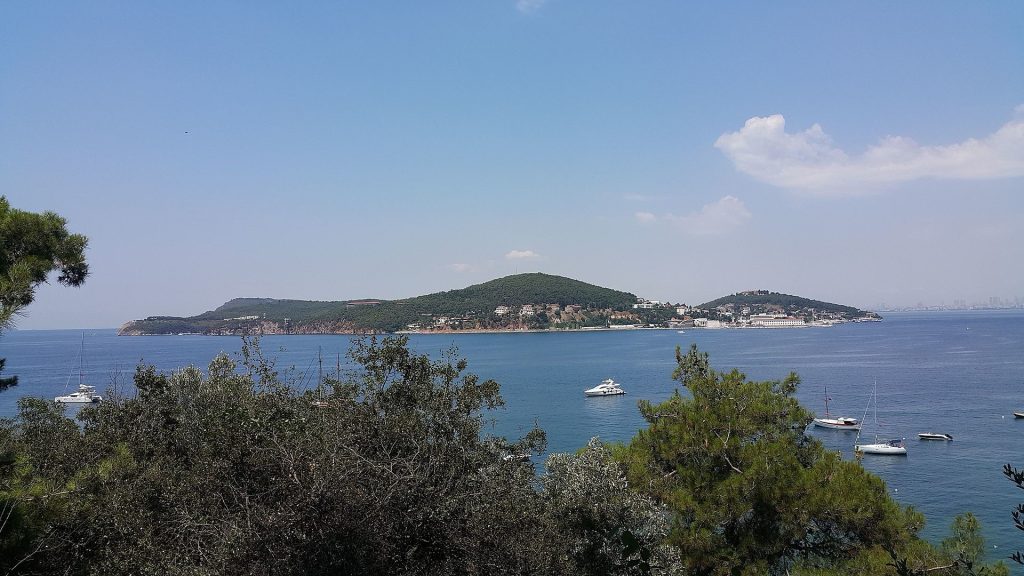
Heybeliada is the second largest island of Istanbul and is known for its historical schools and monasteries. One of the most important buildings of the island is Heybeliada Seminary (Halki Seminary), which was built in the 19th century. In addition, the tranquil atmosphere of the island is ideal for hiking and cycling tours. Heybeliada is also famous for its restaurants and cafes, especially by the sea, therefore you can taste delicious seafood here.
Heybeliada or Halki (Greek: Χάλκη, romanized: Chalki) is one of the 5 neighborhoods and the second largest island of the Adalar district, which includes the Prince Islands in the south of Istanbul. The borders of Heybeliada Neighborhood, the only neighbourhood unit on Heybeliada, are the same as the borders of the island. There are cultural buildings such as Heybeliada Marine High School, Bet Yaakov Synagogue, Aya Triada Monastery and Heybeliada Sanatorium on the island. Geographically, it consists of four hills reaching 140 meters. The island is the second most populated island in summer and winter, and the second most visited island.
Sightseeing places
Close to the pier there stands the Naval High School and the buildings connected to it. By passing through these buildings, you can reach the sanatorium, which is not in operation at the moment, on Çam Limanı side.
There are two historical artifacts on the land owned by the Navy:
The first is Kamariotissa, the last Byzantine Church built before the conquest of Heybeliada. It is thought that the church was built by the last Empress Maria Komnini. It is the only church built based on a four-leaf clover model, except for the Hagia Maria Church in the Fatih district of Istanbul. There is also Aya Yorgi (AyiosYeorgios) Monastery and Tarik-i Dünya Monastery at the western end of Çam Limanı.
The second one is the tombstone of Edward Barton, the ambassador of Queen Elizabeth I of England. There is a Latin inscription with spelling mistakes and Barton’s family coat of arms on it.
The great Greek Church of Aya Nikola (Ayios Nikolaos) is here. The windmill ruins that gave the region its name are still standing.
On the other hill, where there are not many historical buildings, there is Ayia Monastery (Trias Monastery) and the Greek Orthodox Seminary, which date back to the Byzantine Empire. After the conquest, Heybeliada gradually became the main religious education center for the Greek population (secular education continued to be delivered at Greek Orthodox Patriarchate of Istanbul). Clergy candidates used to come from Greece and other Greek-speaking regions to study here. In the 1970s, due to some disagreements between the Turkish government and the Greek Orthodox Patriarchate, the educational activities here were terminated.
In addition to Greek Orthodox religious institutions, there is also Beth Yaakov Synagogue, built in the 1940s.
On the north coast, the mansion of Abbas Halim Pasha, brother of Sait Halim from the Hidiv family, still survives.
There is also İsmet İnönü’s house in Heybeliada. İnönü family moved to Heybeliada in 1924 and stayed here until İnönü’s death. İsmet Inönü’s house is used as a museum today.
Burgazada
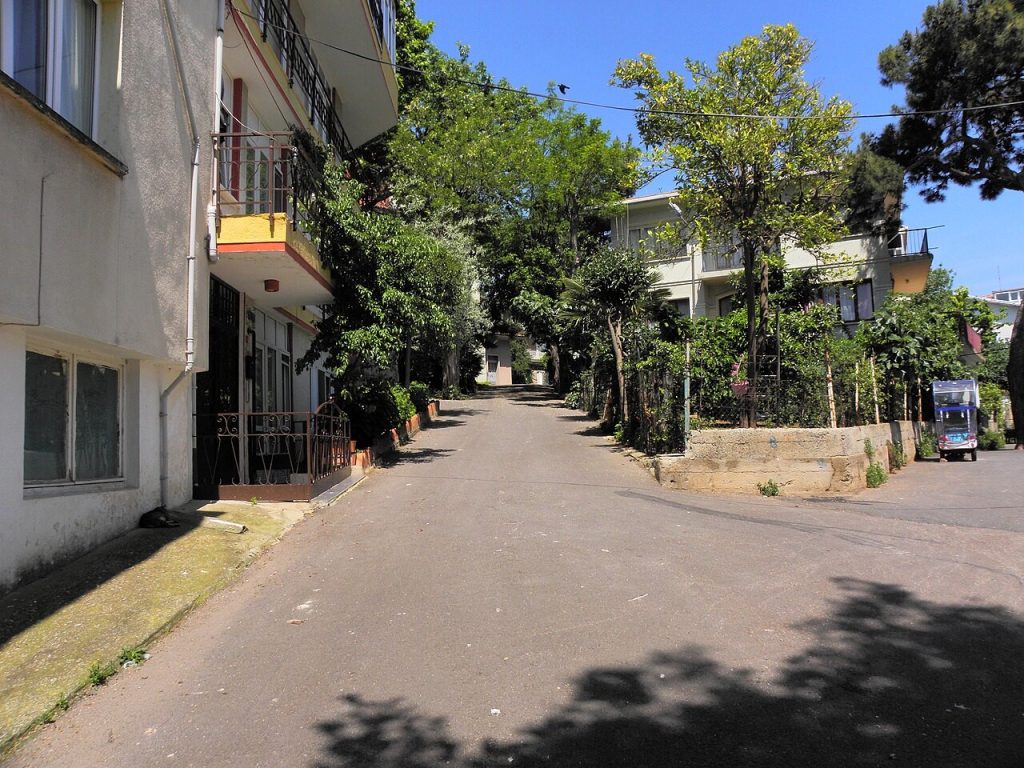
Burgazada offers a calmer and more peaceful island experience. The island is especially known for the house of the famous Turkish writer Sait Faik Abasıyanık. The writer’s house, which has been turned into a museum, is a place frequently visited by literary lovers. The island offers visitors a peaceful environment with small beaches, seafood restaurants and pine forests. Plus, there is a spectacular view from Kalpazankaya at the top of the island.
Burgazada, Burgazada or Antigoni (Greek: ΑντιγόνηAntigóni), is the third in size of the Prince Islands in Istanbul and also a neighborhood of Adalar district. It is round in shape and about 2 kilometers wide. The only hill on the island is Bayrak Tepe. The island is covered with a red pine forest (part of which burned down in 2003). There is also an islet called Kumbaros, which is connected to the island by rocks under the sea, 5 meters from the island.
Antigone, the general of Alexander the Great and father of Demetrios, built a big castle here. The island was first named after him and then took the name Burgaz (Pyrgos), which means castle/fortress in Greek. It is said that Methodios, one of the most respected patriarchs of the Orthodox Church, was imprisoned for seven years in a vault on the island by Iconoclast Movement supporters. Today, Ayios Ioannis Church is located above this vault. According to Evliya Çelebi, the island’s inhabitants consisted of a small number of Greeks, Jews and Armenians in the 17th century. The strait at least 1 kilometer wide separates Heybeliada from Burgaz (Antigoni) Island. Ancient writers called the island Erebinthus and Byzantine writers called it Therebintos or Panormos.
Storyteller Sait Faik Abasıyanık, one of the most important writers of contemporary Turkish literature, spent part of his life here. Burgazada and other Istanbul Islands played an important role in his stories. Abasıyanık’s house in Burgazada has been turned into a museum under the name of Sait Faik Museum.
Burgazada is advantageous in terms of view as it overlooks Heybeliada and Kaşık Island, which are covered with trees. The island is also a favorite corner of Istanbul with its pine forests, beaches and elegant wooden mansions. The best kept beautiful wooden mansions are located on the beach side and the streets at the foot of the hill facing Kaşık Island and Heybeliada. The old beach of the island can be reached by getting off the ferry at the pier, turning left and following the coast. One of the most beautiful spots to watch the sunset on the island is Kalpazankaya. There is a restaurant on this hill on the west side of the island. It is said that the first cast money in Türkiye was produced here. The 176 m high Bayrak Tepe is on a steep slope rising from the south coast of the island. “Hristos Monastery” is located on this hill. Today there are many fish restaurants side by side on the left side of the pier. Burgazada Sanatorium, founded in 1928, is one of the oldest sanatoriums in Türkiye
With the decrease in the population of Greeks in Istanbul, the number of Greeks on the island has also decreased. On the other hand, the number of Jews from Istanbul has increased, and Turks constitutes a large proportion of the island’s population. Austrian priests and nuns live in the buildings belonging to the Austrian High School on the left slope of the island.
A large forest fire broke out in Burgas Island on October 6, 2003. A significant number of trees were burned in this fire due to the strong southwest wind (Lodos in Turkish). The fire was extinguished the following day as a result of aerial and ground extinguishing efforts of the islanders and the fire department. On 450 acres of land, only ten days after the fire, the Istanbul Regional Directorate of Forestry, the Municipality of Adalar, non-governmental organizations and the islanders participated in the reforestation efforts. The efforts have yielded positive results to a great extent.
Kınalıada
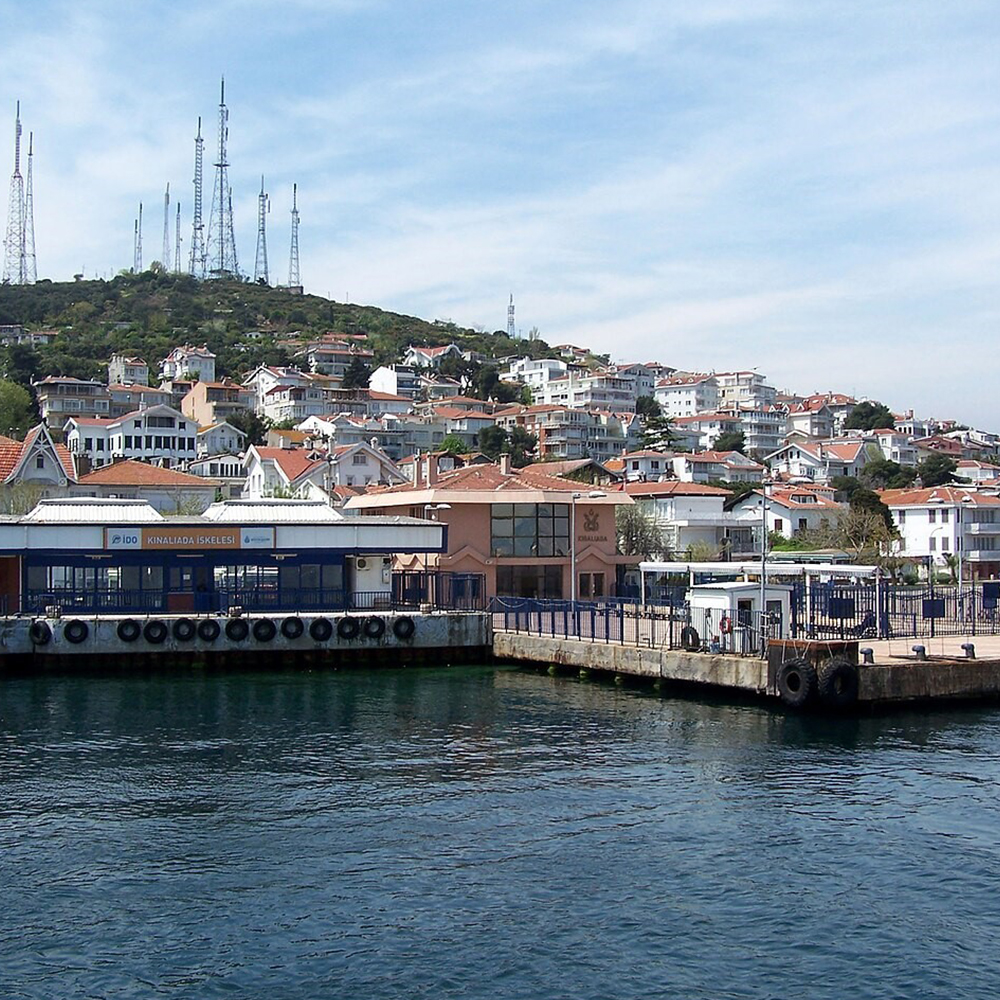
Kınalıada is the closest island to Istanbul and is therefore often preferred by local visitors, especially on weekends. Like its name, the island is known for its henna-colored soil and quarries. Famous for its beaches and seaside restaurants, Kınalıada also awaits to be explored with its quiet streets and historical churches.
Kınalıada (Greek: ΠρωτηProti meaning “first”, Armenian: Գնալըկղզի Gnali kğzi) is the closest island to Istanbul in the inhabited group of islands known as the Princes’ Islands in the Marmara Sea.
It is one of the five neighborhoods of Adalar district. Kınalıada is the fourth largest member of the archipelago, and the borders of the Kınalıada neighborhood, which is the only neighbourhood unit on it, are the same as the borders of the island.
Kınalıada, the smallest of the four large islands in Marmara Sea, can be considered a summer resort today. Although there is a local population living on the island in summer and winter, the population of the island reaches around 3000 with the summer visitors. Since it is quite easy to enter the sea from almost every side, it is said to be the most comfortable island to swim among the Princes’ Islands and for this reason, it attracts many people.[source needed]
History
During the Byzantine period, most of the island exiles were brought here. The most important of these exiles was Roman Diogenes. Its old name is Proti.
It is one of the most bare islands, has the fewest trees and is almost entirely inhabited. Although it gives the impression of a conical island with a single hill when approaching the pier, the remaining 115-meter Çınar Hill and the western skirts of the Manastır Hill are carved due to the quarry that was used to be operated since ancient times. The name comes from the color of the soil, which is reddish due to the iron and copper mines. Its historical texture is also very poor. There are 1 mosque, 2 churches and 1 monastery on the island. Surp Krikor Lusavoriç, the only Armenian Church of the Islands, is here. There is also a Greek Orthodox Christos Monastery located on the location known as Monastery Hill.
Sedef Island
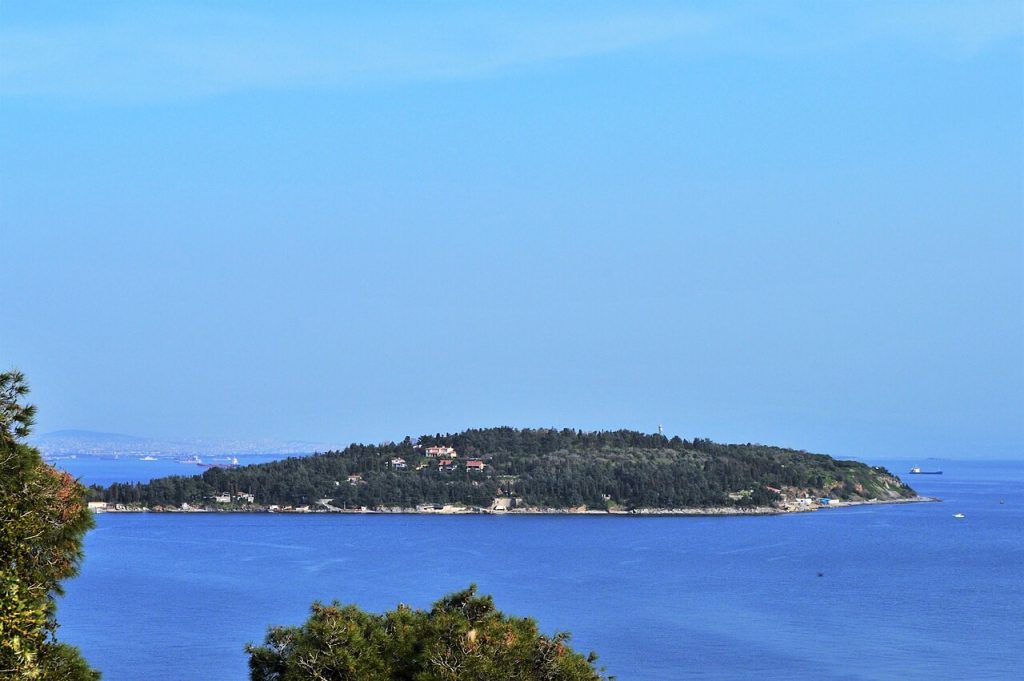
Sedef Island is one of the smallest islands in Istanbul and attracts fewer visitors as it is mostly privately owned. However, the island is known for its natural beauty and untouched beaches. It is an ideal destination for those looking for a quiet and peaceful getaway.
Sedef Island (Greek: Τερέβυνθος Terebinthos and Androvitha or Andircuithos in Antiquity) is the smallest inhabited island of the Princes’ Islands in Istanbul.
It administratively belongs to the Maden Neighborhood of Büyükada. It is 1,300 x 1,100 meters in size. It was named Sedef Island because the flora on it resembles mother-of-pearl when viewed from a distance. Since it used to have plenty of rabbits in the past, the name Tavşanadası (Rabit Island) was also used. Its old name is Terebinthos. From the back side of the island uninhabited Rabbit (Fisherman) Island and Büyükada can be seen.
Sedef Island, like other islands of Istanbul, was used as a place of exile during the Byzantine period. One of the most important exiles of the island was Patriarch Ignatios, who was sent to the island in 857 AD. Ignatios was re-elected as patriarch in 867 after living in the island for 10 years under various tortures.
In 1850, the island became the property of TophaneMüşiri Fethi Ahmet Pasha, and he planted olive trees and grew vegetables on the island. Upon his death, the island was left neglected, and all the trees were cut down during World War I. The Battleship Yavuz, which was captured by the Allies during the occupation of Istanbul, was anchored here for a long time.
The descendants of Fethi Ahmet Pasha tried to make the island a residential area where elite people lived, and for this purpose they formed a housing cooperative, had thousands of trees planted and had villas built. The architect who built the cooperative houses is Kadri Erdoğan is also the architect of Tarabya Hotel.
Yassı Island and Sivri Island
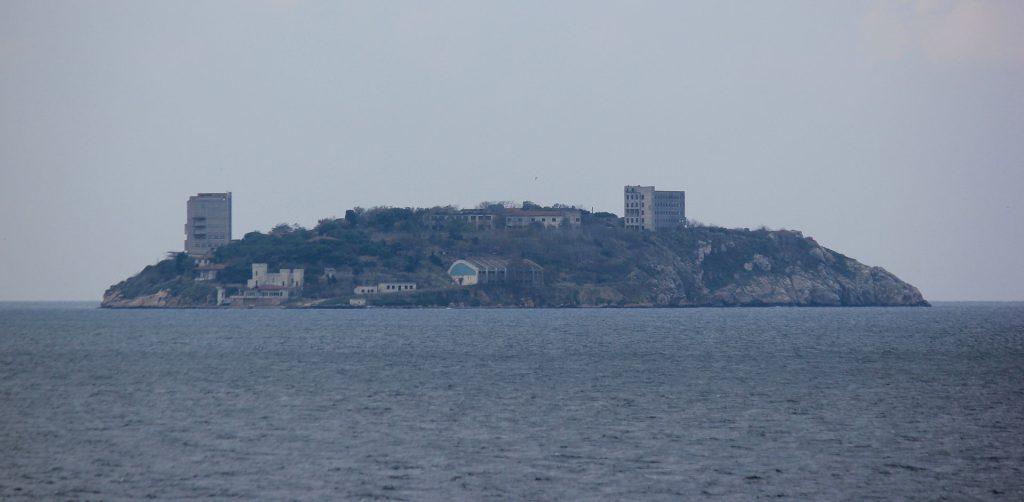
Yassıada and Sivriada are among the least known islands of Istanbul. Used for various purposes throughout history, these islands are especially famous for the political history of Yassıada. Today, these islands are preferred for activities such as diving and fishing.
The Island of Democracy and Freedom, formerly known as Yassıada or Plati (Greek: ΠλάτηPláti), is a small island in Marmara Sea close to Istanbul. It is the flatter of two abandoned islands close to each other, one of which is pointed and the other flat. With a width of 185 meters and a length of 740 meters and a surface area of 18.3 hectares, the island’s terrain is flat, but its beaches generally run perpendicular to the sea. It is 0.9 sea miles (1.66 km) from Sivriada, 2.67 sea miles (4.94 km) from Burgazada and 6.27 sea miles (11.6 km) from Fenerbahçe Island off the coast of Kadıköy. It is also known for the Yassıada Trials, which took place here during the May 27th Coup and here the members of Democratic Party (DP) were judged. In order to erase the traces of the coup, the name of the island was changed to Democracy and Freedoms Island in 2013 in Kadir Topbaş’s second term, with the decision of the Istanbul Metropolitan Municipality Assembly.
History
A miniature by Madrid Skilicis, Ioannis Orfanotrofos exiles Konstantinos Dalassenos to Yassıada.
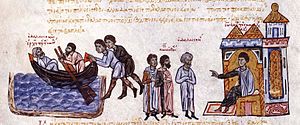
Eastern Roman Empire period
During the Eastern Roman Empire period, Byzantine Emperor Theophilos (reigned 829-842) had a monastery called Platea Monastery built on Yassıada, which was used as a place of exile from the 4th century. In 860, the patriarch Ignatios, who was exiled to this island, had a church built in the center of the island. Later, the cellars under this church were used as dungeons. It was invaded by the Latins in the 12th century and by the Russians in the 15th century.
Ottoman Empire period
After the Conquest of Istanbul, no one showed interest in the island for a long time. Sir Henry Bulwer, the British ambassador to Istanbul, who bought the island in 1859, built a castle-like building with bastions on the beach and a castle-sized mansion in the center of the island in an interesting architectural style.
Bulwer signed an important trade agreement in 1837 while serving as clerk at the British Embassy in Istanbul. After St. Petersburg, Madrid, Washington D.C. and Florence, he was sent back to Istanbul in May 1858 and during his stay as Ambassador until August 1865, he liked the rocky, deserted island and bought Yassıada with the approval of Sultan Abdülmecit.
He brought luxury goods, had two buildings built here in the shape of a small castle, one on the west side and one in the center, and a glass house, and had a garden planted with vine stumps. He welcomed his guests while asking the gardeners about the harvest. When the spring and summer months were over, the British ambassador felt uneasy. Thereupon, he put the island up for sale by placing an advertisement in the Times newspaper in London. This was not an appropriate behavior for the Ottoman government. After a great amount of persuasion efforts, he was dissuaded from this decision.
There is a remarkable story that during the construction of the island, a sarcophagus was found with very valuable jewels, and the Ottoman government asked Bulwer to sell the island to a Turk. This time the land, gardens, vineyards and buildings attracted the interest of Ismail Pasha, the Khedive of Egypt and he buys the island. But he, too, soon gets bored with this island far from the city. Once again, lonely days with a few guards and seagulls begin for the island.
Turkish Republic period
Yassıada was bought by the Navy in 1947, construction began in 1949, and the island was opened for training services in 1952. The Command preserved Bulwer’s castle-type circular pavilion next to the north pier, which still stands today, and built many new buildings such as high-rise lodgings for officers and privates, a sports field, facilities, cold storage, dining hall, and armory. After the May 27 Coup (1960), Democratic Party members were tried in the courts formed here. Adnan Menderes, Hasan Polatkan and Fatin Rüştü Zorlu, among the 15 defendants sentenced to death at the end of the tribunals, their sentences were executed in İmralı Island. The judges and prosecutors who heard the cases traveled here by boat from Heybeliada Panorama Hotel where they were staying. After the Yassıada Trials were over, the island was handed back to the Navy and training activities continued there until 1978.
After the naval forces vacated the island, the desolate days of the island began again. In 1993, the Faculty of Aquaculture at Istanbul University found it a suitable place to work and moved the institute here. Although city line ferries transported professors and students to and from the island twice a day, the distance made it difficult to meet the necessities and the faculty left the island in 1995.
In 2013, the island was renamed as the Island of Democracy and Freedom.[3] Between 2015 and 2018, a 176-person hotel and a 600-person congress center named Adnan Menderes Congress Center, were built on the island. During these works, the gymnasium where the Yassıada Trials were held was restored and turned into May 27th Museum. The construction works, which lasted for four years, were criticized for damaging the historical artifacts and green texture on the island.
The only fish farm of the Marmara Sea is located here. Rainbow trout (Oncorhynchus mykiss) and Çelikbaş trout of 1-4 kg are raised here.
Since it is close to Istanbul and away from sea traffic, it is used as a training area for diving clubs in the city on weekends.
Kaşık Island
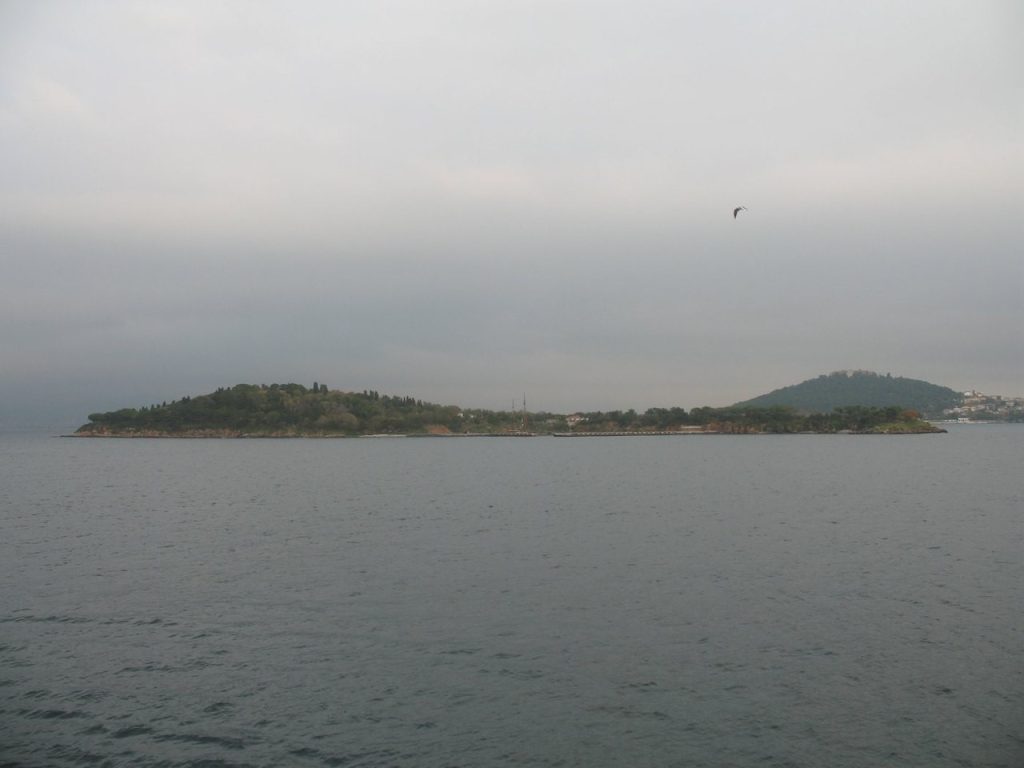
Kaşık (Spoon) Island takes its name from its spoon-shaped appearance and is a small private island. Generally for rental and preferred for special events, the island attracts attention with its natural beauty and calm atmosphere.
Kaşık Island (Greek: Πίτα Píta) is a privately owned small island in the Marmara Sea, located just to the east of Burgazada. There is no ferry service to the island. This island, which is about a few hundred meters long, was being used as a place of exile.
The island, formerly known as Pita and later called “Pide Island”, is more commonly known as Spoon Island due to its spoon-like shape. Kaşık Island, which was owned by a Jewish family named Danon in the 1950s, was sold to a tourism company, but the municipality stopped the construction on the grounds that the company was building facilities that would damage the features of the island.
There are 2 small houses and a simple pier on the island.
Tavşan Island
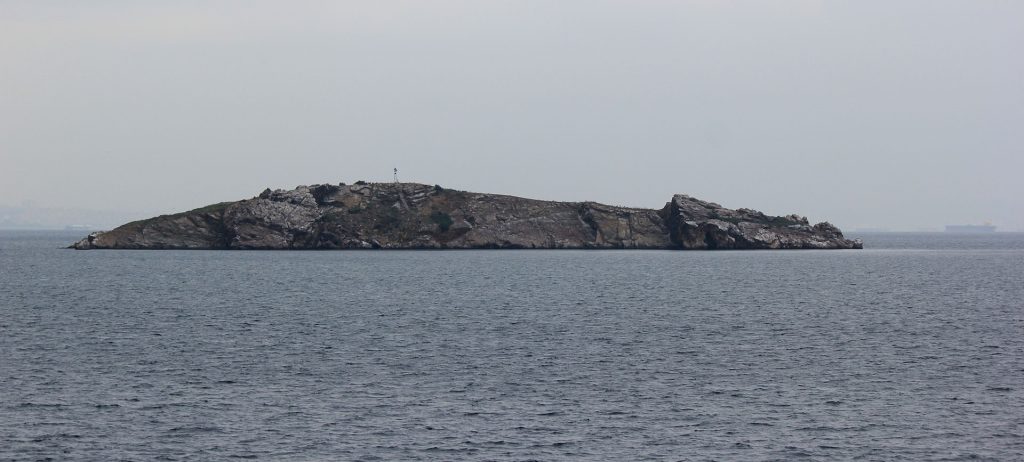
Tavşan (Rabbit) Island is the smallest island in Istanbul and is completely natural. The island is a perfect destination for nature lovers and adventurers. Rabbits and bird species are the natural inhabitants of the island.
Tavşan (Rabbit) Island or Balıkçı (Fisherman’s) Island (Greek: Νέανδρος Neandros) is a member of the Princes’ Islands in the Sea of Marmara. It is a treeless, bare land, on about 2 km south of Büyükada, 90 meters in width and length. There is no settlement on the island due to its small size and barrenness. Like the other uninhabited islands, it is called Tavşan (Rabbit) Island by the peoplebecause of the abundance of rabbits on the island.
The Greek name of Tavşan Island is Neandros. Neandros literally means New Andros. Those who migrated from Andros Island, one of the Greek islands in the Aegean Sea, and settled in Heybeliada formed a colony in Heybeliada (In fact, the area in Heybeliada where today’s HeybeliMektebi Street is located was called the neighborhood of Androsians). The Androsians called this small island on the other side of BüyükadaNeandros, meaning New Andros, to commemorate the name of their own island. Today, this island is also called Niandros and even Yandros. Its official name on the maps is Balıkçı Island.
Tavşan Island does not have a convenient beach. It was used as a quarry in Byzantine times. Ruins of a monastery can be seen on the island.
The islands of Istanbul fascinate visitors with their different features and natural beauties. These islands are perfect places to make historical discoveries and spend peaceful time in harmony with nature. You should definitely visit each island to discover their distinctive features.
Source Wikipedia


